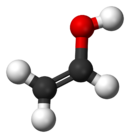Vinyl alcohol
|
|
|||
| Names | |||
|---|---|---|---|
|
IUPAC name
Ethenol
|
|||
| Other names
Hydroxyethene
Hydroxyethylene |
|||
| Identifiers | |||
|
557-75-5 |
|||
| 3D model (Jmol) | Interactive image | ||
| ChEMBL |
ChEMBL76101 |
||
| ChemSpider |
10726 |
||
| ECHA InfoCard | 100.008.350 | ||
| PubChem | 11199 | ||
|
|||
|
|||
| Properties | |||
| C2H4O | |||
| Molar mass | 44.053 g/mol | ||
|
Except where otherwise noted, data are given for materials in their standard state (at 25 °C [77 °F], 100 kPa).
|
|||
|
|
|||
| Infobox references | |||
Vinyl alcohol, also called ethenol (IUPAC name), is an alcohol. It is not to be confused with the drinking alcohol, ethanol. With the formula CH2CHOH, vinyl alcohol is an isomer of acetaldehyde and ethylene oxide. It can be formed by elimination of water from ethylene glycol at a temperature of 900 °C and low pressure.
Under normal conditions, vinyl alcohol converts (tautomerizes) to acetaldehyde:
At room temperature, acetaldehyde (H3CC(O)H) is more stable than vinyl alcohol (H2C=CHOH) by 42.7 kJ/mol:
This keto-enol tautomerization has a high barrier and does therefore not occur near room temperature. This tautomerization can be catalyzed via photochemical process. These findings suggest that the keto-enol tautomerization is a viable route under atmospheric and stratospheric conditions, relevant to a role for vinyl alcohol in the production of organic acids in the atmosphere.
Because of the instability of vinyl alcohol, the thermoplastic polyvinyl alcohol (PVA or PVOH) is made indirectly by polymerization of vinyl acetate followed by hydrolysis of the ester bonds (Ac = acetyl, HOAc = acetic acid):
Several metal complexes are known that contain vinyl alcohol as a ligand. One example is Pt(acac)(η2-C2H3OH)Cl.
Vinyl alcohol was discovered in the molecular cloud Sagittarius B using the 12-meter radio telescope at the Kitt Peak National Observatory. This vinyl alcohol being stable in the (dilute) interstellar medium shows that its tautomerization is not unimolecular.
...
Wikipedia


